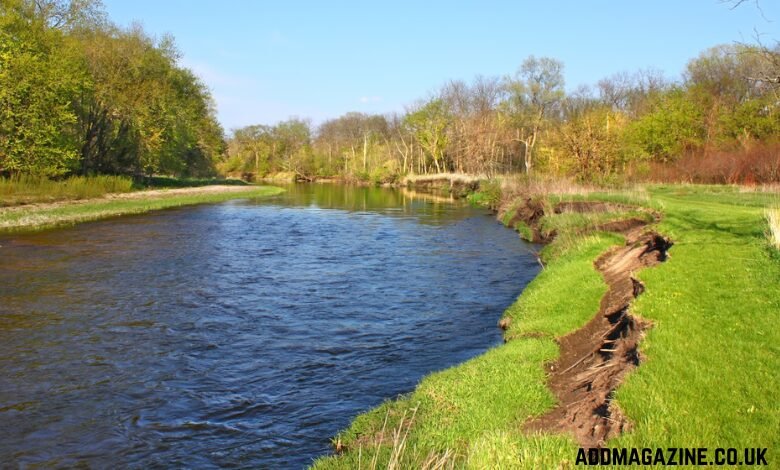A significant section of the riverbank near Iford Playing Fields in Bournemouth, UK, collapsed following a period of strong winds. This incident, which took place in late May, has raised concerns about the stability of the riverbank, its potential risks to local infrastructure, and the safety of those who frequent the area. The collapse, noted by local resident Nicky Adams, took place over a short period, surprising many who had not observed any noticeable changes until the event occurred. This article will explore the circumstances surrounding the riverbank collapse, the possible causes, the implications for the surrounding area, and the measures that can be taken to prevent similar incidents in the future.
Background: The Importance of Iford Playing Fields and the Riverbank
Iford Playing Fields is a public recreational space located in the suburb of Iford, which is part of Bournemouth, a coastal town in the South of England. The fields are well-used for a variety of leisure activities, including walking, cycling, and sports. The proximity of the playing fields to the river makes it an attractive location for outdoor activities, including paddleboarding, swimming, and nature walks. However, being situated near a riverbank also comes with its own set of risks, particularly the possibility of erosion, flooding, and, as in this case, riverbank collapse.
The river that runs near Iford Playing Fields is an important natural feature of the area. However, like many rivers in coastal and suburban regions, it is subject to the processes of erosion, especially during periods of heavy rain or strong winds. These natural processes can result in the gradual wearing away of the riverbank, leading to collapses of varying magnitude. In the case of the recent collapse, however, the extent of the damage has been significant enough to raise alarms among local residents and authorities.
The Incident: A Sudden Collapse
Nicky Adams, a local resident, was one of the first to notice the collapse while walking her dogs on May 29. She reported that the collapse occurred a couple of days earlier, likely around May 27, after the area had experienced a period of strong winds. The damage, which Adams described as occurring almost overnight, was quite significant, with a large section of the riverbank giving way and falling into the water. The fallen embankment carried trees with it, some of which ended up in the river, further exacerbating the damage.
Adams expressed concern that the collapse could present a danger to the public, as Iford Playing Fields is a popular spot for walkers, cyclists, and children, especially during the warmer months. Many people, including families and children, use the fields to swim and play in the river during the summer. The collapse has raised concerns about safety, as the area could be unstable and prone to further erosion in the future.
The Response from Local Authorities
The incident has been brought to the attention of the Bournemouth, Christchurch, and Poole (BCP) Council, which has acknowledged the collapse. A spokesperson from the council noted that the erosion of riverbanks in this area is not uncommon, as it is part of the natural processes of the river. However, the collapse that occurred in late May was considered to be an unusually large section of the bank. The council has indicated that they are monitoring the situation and are seeking advice from partner organizations to determine what steps should be taken next.
While the council’s response indicates that they are aware of the situation, many local residents have expressed frustration at the lack of immediate action or communication regarding the collapse. Posts on social media platforms, such as Facebook and Twitter, have raised concerns about the long-term safety of the area, as well as the potential risks to public infrastructure, including the playing fields and the nearby train bridge. Some residents have even questioned who is responsible for addressing the collapse and what actions are being taken to prevent further damage.
Causes of Riverbank Collapse
The collapse at Iford Playing Fields, although unexpected, is not an isolated incident. Riverbanks are naturally susceptible to erosion, especially in areas where they are exposed to strong winds, heavy rainfall, or fluctuating water levels. Erosion occurs when the soil and vegetation along the riverbank are worn away by the movement of water, wind, or ice. Over time, this can lead to the undermining of the bank’s structure, causing it to give way.
Several factors may have contributed to the collapse at Iford Playing Fields, including:
- Weather Conditions: The period leading up to the collapse was marked by strong winds, which could have contributed to the destabilization of the riverbank. Wind can have a significant impact on the structure of a riverbank, particularly if the soil is already loose or waterlogged.
- Heavy Rain: If there had been a period of heavy rain prior to the collapse, the increased water flow could have eroded the bank more quickly. Rainwater can saturate the soil, making it heavier and more prone to collapse when combined with strong winds.
- Vegetation Loss: The collapse led to several trees falling into the river, which suggests that the root systems of these trees were likely part of the structure of the bank. Loss of vegetation can exacerbate erosion, as plant roots help to bind the soil together and prevent it from washing away.
- Natural Erosion: As the BCP Council noted, erosion is a natural process in this area. Over time, the river slowly wears away at the bank, which can eventually lead to significant collapses. This process is often exacerbated by human activity, such as urban development or construction near the riverbank, which can alter the flow of water and disrupt the natural stability of the land.
Potential Risks and Consequences
The collapse at Iford Playing Fields has several potential risks and consequences that should be addressed to ensure public safety and protect the surrounding environment. Some of the main concerns include:
- Safety Hazards: The most immediate concern is the safety of individuals who use the playing fields and the riverbank. The collapse has created an unstable area that could pose a danger to pedestrians, cyclists, and especially children who may be unaware of the risks. The presence of fallen trees and other debris in the river could further complicate the situation.
- Further Erosion: If the underlying causes of the collapse are not addressed, there is a risk that further sections of the riverbank could erode or collapse. This could lead to the destruction of more land, including areas used for recreational purposes, and may even threaten infrastructure such as the nearby train bridge.
- Environmental Impact: The collapse could also have an impact on the local environment, particularly the river and its surrounding ecosystems. As trees and other vegetation fall into the water, they can alter the flow of the river, disrupt habitats, and affect the quality of the water.
- Loss of Public Space: If the collapse leads to further erosion or a decline in the stability of the riverbank, there is a risk that Iford Playing Fields could become less accessible or even unsafe for public use. This could be a significant loss for the local community, as the fields provide an important space for outdoor activities and recreation.
Steps to Address the Collapse
To properly address the riverbank collapse at Iford Playing Fields, a multi-faceted approach is needed. Here are some of the steps that local authorities, environmental agencies, and the community should consider:
- Assessment of the Damage: The first step is to assess the extent of the damage and determine the underlying causes of the collapse. This will involve surveying the area, analyzing soil conditions, and studying the impact of recent weather patterns.
- Stabilization of the Riverbank: Once the causes of the collapse are understood, measures should be taken to stabilize the riverbank and prevent further erosion. This could involve reinforcing the bank with additional vegetation, such as planting trees or shrubs with deep roots, or installing structures like retaining walls or gabions to hold the soil in place.
- Monitoring and Maintenance: Regular monitoring of the riverbank should be conducted to ensure that erosion does not worsen and that any early signs of instability are addressed before they lead to further damage.
- Public Awareness and Communication: The local authorities should communicate with the public about the risks associated with the collapse and any actions being taken to address the issue. This could include issuing warnings, closing certain areas to the public, or providing information on how to safely navigate the area.
- Collaboration with Experts: The council and other relevant organizations should work with environmental experts, engineers, and other specialists to determine the best course of action for addressing the collapse and preventing similar incidents in the future.
Conclusion
The riverbank collapse at Iford Playing Fields has raised important questions about the stability of the area and the safety of those who use it for recreation. While erosion is a natural process, the extent of the damage suggests that further action is needed to address the risks and prevent further incidents. By assessing the situation, stabilizing the riverbank, and working with experts to implement effective solutions, local authorities can help ensure that Iford Playing Fields remains a safe and enjoyable space for the community.




